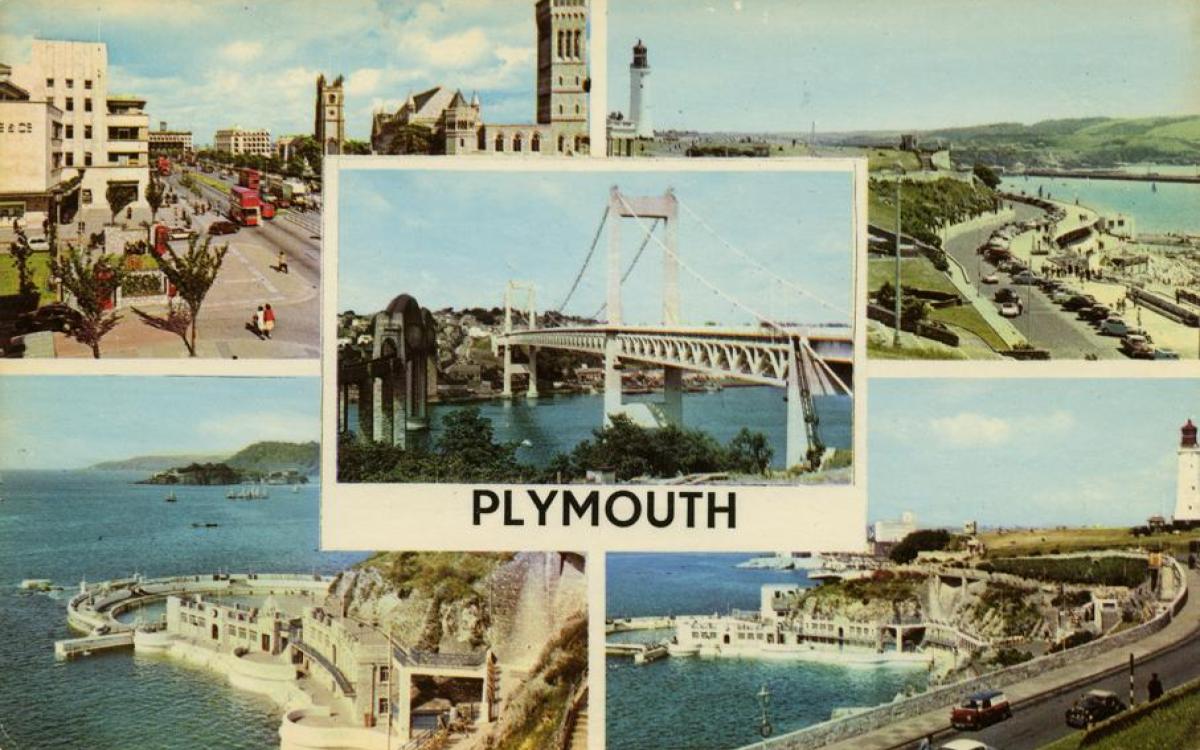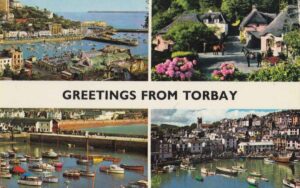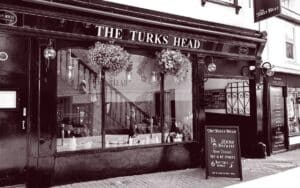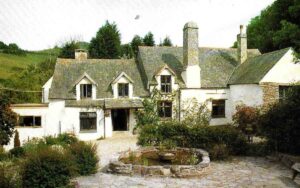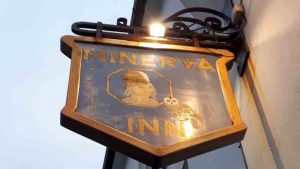KEVIN HYNES – author of Haunted Plymouth – takes us on a paranormal tour of Plymouth, showing us its most ghostly and haunted places to visit
Elizabethan House, Plymouth
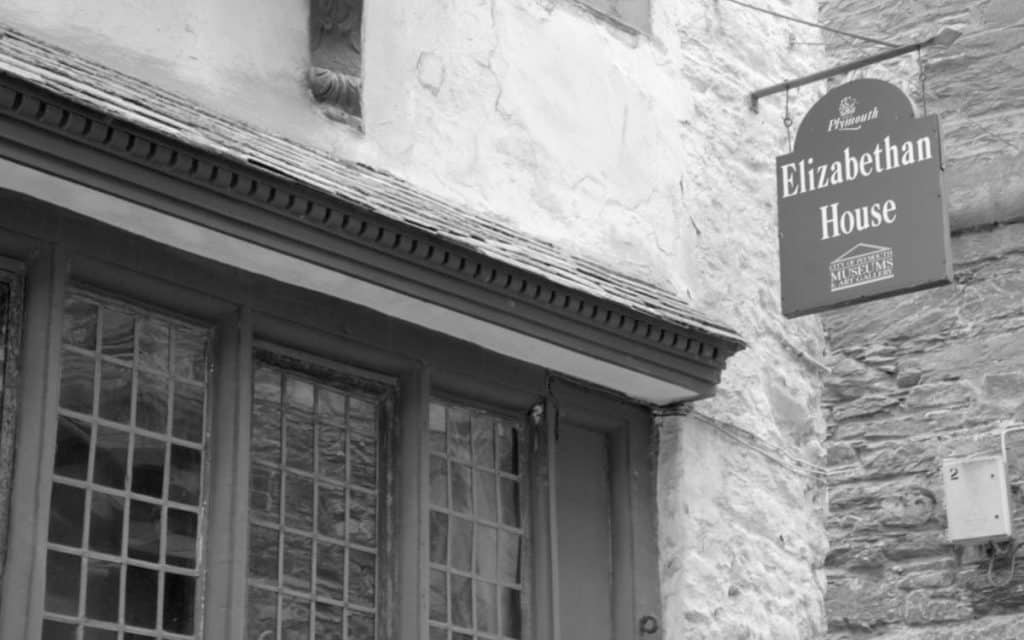
In the late 15th Century, Plymouth was a prosperous, bustling port, with the influx of ships and crew, not to mention privateers, craftsmen and merchants. The need for new housing was imperative; this led to the development of New Street. A number of the properties were purposely built for the likes of sea merchants and sea captains who relied upon the proximity of the sea for their livelihood.
The Elizabethan house dates from 1584 and is a restored captain’s dwelling. Even today, it is not hard to imagine the likes of Sir Walter Raleigh, Drake and Captain Cook strolling down these narrow cobbled streets.
The most famous and well-known story is that of an archaeologist from the Plymouth Museum, who had an unexpected experience on a very cold, dark, dank October evening in 1983.
The gentleman had arrived early to set up and prepare for the evenings lecture.
It was around dusk when he first entered the Elizabethan House and he made his way up the old Elizabethan winding staircase. Although, as he ascended the stairs, he heard a most peculiar sound, so he hurried to find the source of where this strange noise was emanating from.
As he entered one of the upper floor rooms to his amazement he saw a small wooden child’s cradle rocking from side to side all by itself, it was as if some kind of invisible force was indeed rocking the cradle at a steady pace.
At this point he turned heel and hurried down the spiralling staircase feeling slightly unlevered at what he had just witnessed.
By now a number of his guests had started to arrive, it was at this point that he felt compelled to inform them of what only moments earlier he had just witnessed upon the upper levels of the Elizabethan House.
He even managed to convince a number of his guests to join him upstairs to see if the child’s cradle would once again move freely upon its own accord. So once again the lecturer ascended the old wooden stairs followed by a handful of his guests.
They entered the room and stood around the child’s cradle. At this point the cradle was stationary and everyone talked amongst themselves joking about the situation, but the laughter was cut short and silenced, as it was at this point the cradle did indeed start to rock once again from left to right.
Local legend states that a figure of an infant child has been seen within this small wooden cradle. This has been witnessed only for a brief moment and then the apparition suddenly vanishes.
Also a figure of a young girl, aged around seven to nine, has been witnessed sitting in the corner of the 1st Floor room. A number of people have seen her looking out of the window whilst they have been walking around the upper floor of this building and passers-by in the street have been drawn to look up at this window. On a number of occasions, passers-by have caught a glimpse of this child like figure looking back at them.
There are many reports of cold spots within the Elizabethan House even on a very hot summer’s day, it is claimed that certain areas become icy cold even if only for a brief moment. Certain members of staff have commented, whilst they were on the ground floor, items of furniture has been heard being dragged around the upper levels, although upon inspection nothing is reported to be out of place.
The Royal William Yard
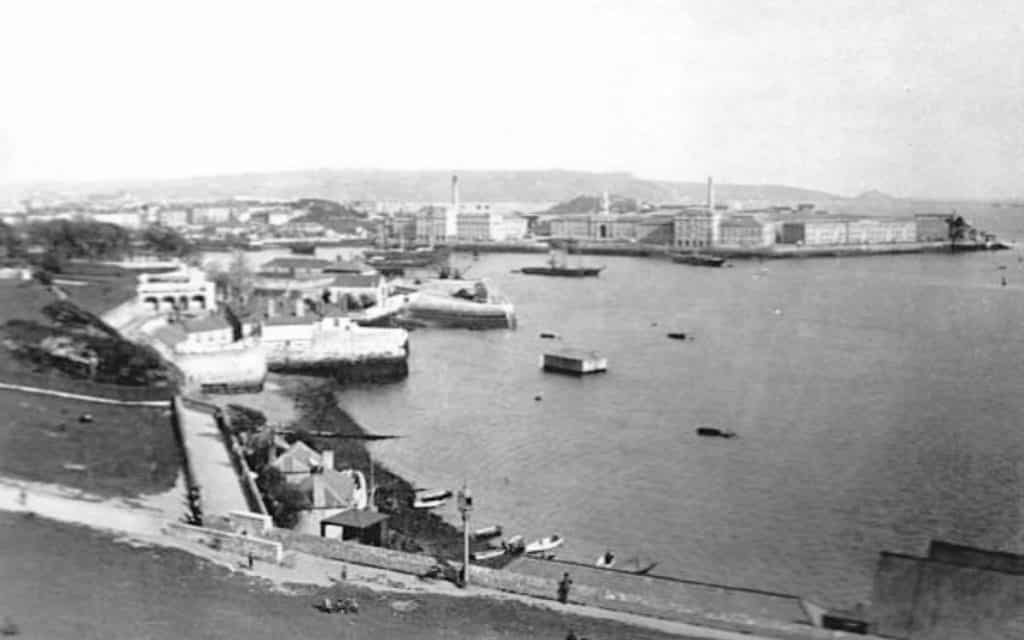
The Royal William Yard was designed by Sir John Rennie (1794-1878).
Situated upon 16 acres the Royal William Yard’s main purpose was as a victualing (food and provisions) depot for the Royal Navy. Work commenced in 1826 with the construction being completed in 1835.
Upon entering the large granite archway a twelve foot stone statue of King William can be seen towering from its impressive plateau. Just located off to the right of the entrance was once situated the old Slaughter House and to the left hand side stood the Old Police House. It is known that no fewer than 250 personnel were employed in the yard at its peak.
In 1993 the yard was closed and taken over by the Plymouth Development Corporation; after several millions of pounds were spent developing the Royal William Yard has been given a new lease of life and transformed, with many buildings being converted to luxury apartments.
Many individuals in its glory days would have plied there trades behind the large stone walls that surrounded the perimeter of the Royal William Yard. The likes of Bakers, Butchers and Coopers to name a few, therefore it was apparent that a small community lived and worked upon this area alongside the Naval Officers based at the Yard.
With such a fascinating history it is of no surprise that fellow trade’s and service personnel held this area very dear to them in life and for a small handful in death too. As in recent year’s paranormal sightings, sounds have been quite the norm of everyday life. Other supernatural activity has included noticeable temperature drops in certain areas of the yard.
The Parade Ground which has today been grassed over once housed cattle to await their fate as Bully Beef, on a number of occasions mostly during the late evening’s it is not uncommon to witness the eerie ghostly sound of cattle hooves stamping upon old cobbled stone, even though this very area is today grassed over, this unnerving sound has been heard even up to the present day.
I have been given fresh new information from a very reliable source who at the time of writing is working at The Royal William Yard for a building contractor. It seems apparent that the paranormal activity that is still occurring even today. The previous accounts refer to January 2010.
In Residents 1 a tradesman heard the sound of someone moving upon the stairs, which was most bizarre. It sounded as if it was a woman in a large dress (liken to the sound of a long flowing wedding dress) as the sound of material could be heard moving up the stairs upon immediate inspection there was no sign of anyone being present.
Another odd occurrence is that of the sound of old parlour music in one particular area of residents 1. Once again there is no obvious source for the phantom music.
One gentleman had quite a shock as he was carrying out an inspection up a ladder at the rear of the Old Police House. His attention was drawn through a window which he saw with his own eyes a male dressed in an old style Police Officers uniform, the one thing that added to this spooky incident was that the gentle also had an old style handle bar moustache.
A woman in Residents 2 on the 1st Floor witnessed a full blown apparition on a male dressed in an old naval officer’s uniform.
There is an oppressive feeling that has been witnessed by a few individuals in the vicinity of the Melville Clock Tower.
I have also been informed recently that when building work was undertaken in the old Mills and Bakery within the past 10 years, a number of spooky occurrences have happened. The heavy wooden doors located in this area which were at the time coated with metal for fire protection were known to open and shut on their own accord. I have been told that these doors are not easily moved due to their weight.
Reel Cinema
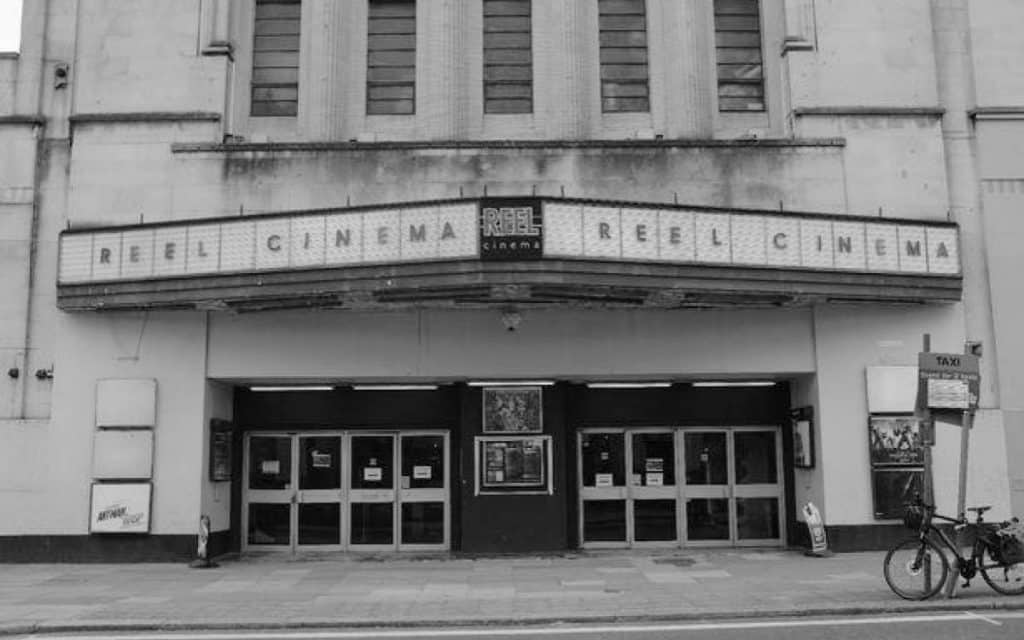
The Reel Cinema Plymouth, previously known as the ABC cinema, is situated at Derry’s Cross.
On the 11th April 1937 Plymouth’s old Theatre Royal was demolished and in its place arose The Royal Cinema owned by the Associated British Cinema’s (ABC). The Cinema opened on the 15th July 1938. The ABC is one of only a handful of buildings that survived the Plymouth Blitz during the 2nd World War.
The Beatles performed on stage at the ABC on Wednesday November 13th 1963.
Today, Reel Cinema is renowned to be a very haunted location. In recent times a wide array of paranormal activity has been witnessed first-hand by both the Cinema’s staff and paying customers, therefore it is no surprise that a number of paranormal investigations have taken place at this location.
The entire area of Derry’s Cross where Reel Cinema is situated today is also known to be paranormally active, there is documentation stating that within this small area at least three burial grounds were indeed located here. One of these old burial grounds was used as a final resting place for a number of Napoleonic prisoners of war. It is also quite common for building ground works in this area to be stopped and delayed, due to the wide collection of human remains that have been unearthed.
Previous paranormal activity at Reel Cinema
Screen 2 within the cinema seems to be one of the most active areas, as the full manifestation of a woman in white has been seen at the back of the screen room.
Also another female has been sighted in a particular seat on one of the front rows also in screen 2 – although during the viewing of film’s people have been left puzzled as the woman vanishes and is nowhere to be seen. A number of paying customers have indeed sat in this very seat that is sometimes occupied by this phantom female, afterwards commenting on feeling watched, uneasy and sometimes becoming suddenly quite ill therefore leaving screen 2.
The ladies toilets are reported to be very active with feelings of being watched, to people experiencing poltergeist activity, loud inexpiable noise’s to name a few whilst spending time in this area.
I have personally had the pleasure in taking part in two separate all night paranormal investigations at Reel Cinema.
My first nights vigil at Reel Cinema then known as the ABC took place on Friday 28th April 2006. I led a team of 16 paranormal investigators on that April night to uncover the truth behind the hauntings at the impressive ABC Cinema.
On Friday 16th October 2009 I returned to undertake an all-night paranormal investigation at Reel Cinema with my team. You can read the full report in my book Haunted Plymouth. At the time of writing Reel Cinema is currently closed with a decision awaiting its future.
Black Friar’s Distillery
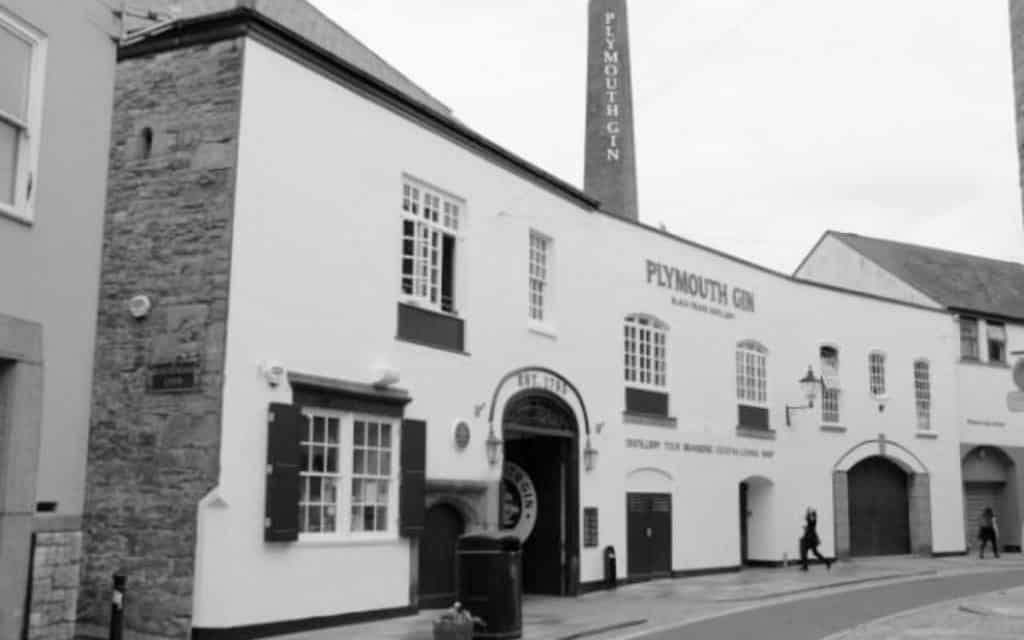
This building is the oldest working Gin Distillery in all of England, world famous Plymouth Gin has been produced here since 1793.
The building dates as far back as the early 14th Century, the most intact part of the building is the refectory room which was once a medieval hall and has a hull shape timber roof built in 1431, therefore making this building one of the oldest in Plymouth. The distillery was once formerly a monastery inhabited by the Black Friars.
Other uses for this building have included it being a debtor’s prison. It is also believed that a number of the Pilgrim Fathers spent there last night here in 1620 before making the short walk down to the harbour to set sail on their epic voyage to start a new life in America.
In regards to spirits there are indeed a number who reside within the old stone walls of Plymouth Gin and I’m am not talking about the ones in the bottle. In more recent times a number of all-night paranormal investigations have taken place at the Distillery and a wide array of presences have indeed been seen and picked up by psychics, in more recent times I have personally had the pleasure in spending all night at this haunted location.
On a historical note during the Second World War, part of Black Friars Distillery was hit by a German fire bomb. The distillery offices and many of the records were destroyed which left the production crippled by ingredients rationing at this time.
Back in 2009 I had the pleasure in having a guided tour by Rose who is a member of staff at the Black Friars Distillery. Whilst on my brief visit I questioned Rose what previous paranormal activity has been witnessed over the years. Rose mentioned a few of the experiences and presences that have been encountered over the years and too confirmed what Paranormal Groups have previously picked up during their time spent at this ancient location.
To name a few the most commonly witnessed is that of a young girl named Lucy who is believed to roam around the whole of building.
The ghost of a man named Charles is said to haunt the Still room, Charles has a dislike for Woman.
A young prostitute named Elizabeth has also appeared in the past.
Mediums have also sensed a tragic past event that occurred in the area that is today the ladies rest rooms. It is believed that a lost female soul haunts this very area; she met her demise after being brutally stabbed to death upon this spot. Today a number of women who visit this area claim to be overcome with pure dread, not many hang around to find out why there is such an oppressive feeling in this part of the building.
Therefore could this be the lost soul of the murdered victim who passed in such a horrific way, is she responsible for making her self-known to those who visit this place even up to the present day.
I have also been informed that a Monk like figure has been sighted in certain parts of the ancient site.
This location features on my Haunted Plymouth Ghost Walk and in the past a number of the female ghost walk participants have commented on the ladies rest room and stated that the atmosphere in this area indeed feels very oppressive. One woman actually stated that she would never return to this area as it felt so negative and that something did not feel right.
Devonport Dockyard
My good friend and fellow paranormal investigator Mr Stuart Andrews had the honour of spending two consecutive nights investigating the mysterious hauntings associated to the Royal Naval Base at Devonport.
Stuart has kindly submitted the following report findings from his time spent at Devonport Dockyard.
On the 28th and 29th of May 2004 the Royal Navy in conjunction with the Society of Metaphysicians and Brunel University invited two paranormal groups to spend the weekend in the South Yard Ropery of HM Naval Base Devonport. I was privileged to be invited for this unique event covering two nights, with Becky Andrews joining us for the second night which allowed an interesting comparison of a fresh pair of eyes, unaware of the first night’s findings.
The Navy’s intention was to use the findings to support the many encounters reported by security, police and base personnel from over the years as promotion for their planned visitor centre. The South Yard Ropery was a major production centre for rope and cordage for the entire Royal Navy until its partial destruction by the Luftwaffe in March 1941.
The site has a huge part within Britain’s history, dating back to 1691, even earlier, the ships of Sir Francis Drake’s fleet set sail from the mouth of the River Plym in 1588 to defeat the ill-fated Spanish Armada. Today Devonport is famous for being the largest Naval Base in Western Europe, covering 650 acres with four miles of coastline within the huge imposing citadel walls surrounding the base. Within this secure perimeter are 15 dry docks, 5 basins and 25 tidal berths.
Its 2,500 service and civilian personnel and the defence work they undertake is estimated to contribute 10% of the total income for the city of Plymouth. The Devonport flotilla includes 14 Type 22 and 23 frigates, 7 Trafalgar class submarines, as well as the Royal Navy’s largest ship, HMS Ocean with a displacement of 21,000 tonnes. Devonport is being developed as the Royal Navy’s centre for ‘Amphibious Excellence’, being home to the latest amphibious assault class vessels, HMS Albion and HMS Bulwark. Both able to rapidly deliver a substantial payload of Royal Marines, their vehicles and equipment through the next generation of landing craft, to any place in the world as required.
The Navy’s smallest ship also claims this as its home, HMS Gleaner, the 25 tonne surveying motor launch. The UK Hydrographic Agency, based in Taunton, Somerset, are responsible for maritime cartography across the world also has four of its five survey ships ported here.
Returning to the paranormal investigation, two main areas were the focus of the weekend, with both teams spending a night in each. The first being the Ropemaker’s House, a grade II listed building constructed in the late 18th century as the home for the Master Ropemaker, since world war two it has been used as a residence for dockyard officials.
Over the years it has gained the reputation of the most haunted house in Plymouth, it certainly looks the part and on entering you immediately encounter a timeless feeling. Since 2000 however the building has been vacant and earmarked for development of the proposed visitor centre, a project which at the time of writing has suffered further delays in realisation.
The second area included the surviving Ropery building, a vast multi storied structure built for the production of rope, its huge open areas similar to those at the Royal Dockyard at Chatham, necessary for the production of long lengths of rope and cord. In the dark it was almost impossible to see one end from the other, despite high powered torches.
Nearby to both the Ropery and Ropemaker’s House is another block of granite faced buildings erected in 1766 and originally used as a Tarring building. One of the smaller sections is named the Hangman’s Cell and was formerly a Wheelhouse. According to records, it was the scene of the execution of over a 100 (some say as many as 141) French prisoners of war from the Napoleonic era.
Somewhat surprisingly the majority of these executions are believed to have been carried out by the captured French officers, who retained responsibility for maintaining discipline of their men. Life in the services back then was extremely hard, with corporal punishment readily handed out to both Naval and Army personnel on both sides. It is alleged that a nail was driven into the wall for each life taken here, with the hangman from Plymouth attending to oversee the gruesome tasks.
Still in situ is what is apparently the only surviving, functioning mechanised trap; above which hangs, a not always motionless, noose (presumably of Devonport rope) as a grim reminder of the harsh discipline meted out. The plaque above further detailing: “This is the execution cell used during the Napoleonic Wards for prisoners who were victimes of the harsh laws.”.
Ropemaker’s House
After passing security checks I entered through Cranby Gate and was directed to Flotilla House for a detailed briefing by the Base Commander, Charles Crichton, and a chance to meet the other team. It was then that the realisation of how big and serious a project this was really hit home. 20 experienced investigators and a comparable number of highly skilled and senior base personnel were all dedicated to spreading out in the search of evidence to support the previously reported spectral encounters.
A vast array of equipment was deployed, including the biggest range of trigger objects and experiments I have ever seen at an investigation, justifying the worldwide media coverage that this weekend attracted. Following the base readings and familiarisation of the Ropemaker’s House by our team, a rest session was called and a chance to compose our thoughts and adapt our investigation plan to best fit the huge area available. Suddenly 10 of us seemed to be way too few!
Our team was also lucky enough to be joined by Mr & Mrs T who had previously resided within the house, their first-hand account of the activity experienced, along with the expertise of the base personnel really helped us to focus our efforts. Although details were not disclosed to us until we were halfway through the investigation.
Poltergeist activity has been often reported, with phantom footsteps running up the stairs, spectral noises coming from empty third floor rooms, furniture moving and being overturned. Perhaps most bizarre is the report from previous occupants who found the work surfaces of the kitchen being torn to shreds overnight.
At times, the activity has become dangerous with both children and adults being pushed on the stairs and in the corridors. Sounds from another time have also been reported outside, with the echoes of a horse and carriage being heard bouncing back of the impenetrable granite walls surrounding the base. We certainly gained the impression that these events were not isolated incidents from one or two people, many staff have reported encounters from within the house and either refused to enter, or avoid working in particular rooms.
The area where I had the most unusual encounter was on the third (top) floor corridor and the three rooms leading off. Most of us picked up on a very heavy and oppressive atmosphere, with a feeling of resistance on certain steps of the staircase leading up to the third floor. A pressing sensation on the chest and shortness of breath was also experienced, this was still there on repeat visits, but not there during the vigil held later on in the night or on the Saturday.
At 10.50pm once we had returned to Flotilla House, the other team were returning back from the Hangman’s Cell with one of them showing clear signs that she was very distressed, apparently attacked or disturbed in some way by an entity during their séances and vigils.
We did experience some of the lights turning themselves on and off, with no one in the area, which was caught on camcorder. This is one of the more common reports from the house, but we were unable to conclude whether this was of paranormal origin or due to faulty electrics. But as with the Security and Navy’s reports of this happening on several occasions, we could confirm that human intervention was not responsible.
Strangely it was very difficult to capture a good photograph within this building over the entire weekend, whether day or night all of my shots were uncharacteristically blurred, out of focus or displaying other anomalies. Sadly we did not encounter the 18th century bearded sailor seen wandering the dockyard, some report him to be humming and smiling which has led to his nickname of ‘the smiling sailor’. Also reported is an 18th century naval officer, observed staring out of a top floor window and a lady in a splendid cream dress gliding around the main bedroom.
Perhaps the saddest accounts are the repeated sightings, and sometimes interaction with, of both a little Victorian girl aged between 5 and 10 playing with a doll; and of another 6 year old girl playing with a toy box, both seem to haunt the upper floors, again, especially the third.
Night 2: The Execution Cell & Ropery
It is fair to say there was a great deal of anticipation felt by the team as we all entered the Hanging Cell for the first time together, the range of reports and words of caution from the other team prepared us for what might be a very active night. Even the archway through the main building, which outside of the cell led down to access the Dissection Room below, had a gloomy, almost oppressive atmosphere to it. Made all the more so, by the stark shades of the granite facing blocks.
Whilst entering the Dissection Room, what appears to be an old mortuary table greets you, along with a now bricked up alcove behind, it’s said to have been used to shoot prisoners through, should the noose not readily complete its macabre work. We were told by the base commander himself, how military police had even recently reported loud banging sounds coming from within the locked and empty rooms.
Other reports include a bubbling reaction from a nearby covered area during heavy rain in the 1960’s; presumed to be the burial pit where the recently executed were unceremoniously buried with a covering of quicklime.
Our expectations were sadly not met, and the time passed without incident besides some technical difficulties and equipment failure. Although many believe such events accompany haunting experiences, this has to remain anecdotal with coincidence a factor that cannot be ruled out. We were not fortunate enough to experience this or any of the other reported phenomenon; which also includes the ghosts of a 20th century suicide by hanging, and that of a murder victim in a nearby former latrine, his fate decided by others due to his alleged homosexuality.
On reflection this might have originated as a warning to sailors to avoid the temptation of such pursuits, we have also encountered a similar account from the North Caponier at Coalhouse Fort in Essex. If not of urban legend or naval lore, then it is truly disturbing to think of two similarly concealed accounts, and how often this might have occurred elsewhere, possibly omitted from official records.
I then joined some of the base personnel and members of the other team for a walk around the other areas of the South Yard, there was so much ground to cover so I left the main team, including Becky, keeping a silent observational vigil of both the Hanging Cell and Dissection Room. Neither I nor the naval staff encountered anything unusual, but one of the mediums felt a sensation of being pushed backwards, whilst walking down to a linking tunnel.
There was a strong wind blowing up another tunnel, which links the existing Ropery and the site of the bomb destroyed Ropery. Experienced at a time the medium was obtaining information, further research since leads me to conclude that this would be the wind flowing over the wall and then sinking to the base of the wall and being drawn up the tunnel. It was very interesting to see the full site of both the existing Ropery and it’s bombed out sister building from the other side.
I was able to gain a vivid impression of what they both would have previously looked like during their heyday.
At 1.30pm the next vigil began in the Hangman’s Cell, various experiments and techniques were employed, including singing and talking in French, These sadly produced no results, except for a few anomalies on the night shot camcorders and digital cameras. These could all be argued as having rational explanations, including a previously captured image of a dark face which appeared in the floor inside the Ropery. Attempts to recreate this were successful and clearly due to a natural pattern within the floor.
Otherwise known as Pareidolia, the human mind will try and match what the eyes report to the brain with known associations; the human face is one of the most common, as it is the first we learn as young children, recognising the outline of our parents. Unfortunately nothing further was picked up by any of the team and this session was terminated at approximately 2.30pm.
After a rest session, we moved back into the Ropery, whilst the other team focused on the areas of the Ropemaker’s House, which they were finding to be most active. According to Nancy Hammonds ‘Ghosts of Plymouth’, a man wearing belt and braces over an unjacketed shirt has been seen in here.
Sadly we did not encounter any such apparition but I must say that this was the one area of the base I felt distinctly unwelcome in, as if being watched and our presence strongly disapproved. Perhaps this was due to it being such a cavernous area, but this was certainly in stark contrast to the Hanging Cell, despite the latter’s preserved state.
After the investigation
At 4.45pm it was decided to call it a night, but there was time for one more event to investigate. Whilst walking back to the Ropemaker’s House a couple of us heard a loud, heavy dragging sound coming from the area of the Hangman’s Cell. Slightly nervously and alone, I walked around the corner to find the cause of this sound, traffic barriers being moved around by the base commander. In the end I gave him more of a fright as he did not hear me walk up behind him!
The results showed that the psychic team experienced significantly more activity at both locations during both nights. This supports the idea that those with perceived psychic ability report a greater number of paranormal events. Whether this is due to their abilities, or their often firm beliefs priming them to expect such encounters, therefore finding them, is an unanswered question for the reader to consider. Subsequent enquires with the base revealed that a follow up investigation was carried out by the medium orientated team a few months later, details of which were never publicised.
However it is understood that the levels of reported experiences within the base have quietened down since, with no further accounts available from between the initial investigation and the present day. Despite the lack of any hard evidence gained during the weekend (after all two nights is quite a short snapshot of time to expect to experience a haunting); this was a truly unique investigation which did raise many questions.
Could it be that the spirits at Devonport only wish to make themselves known to those they can feel an affinity with, or a hatred for? A large number of the sightings and encounters have been reported by Naval and Security personnel, it was also a Police worker from the psychic team who had the most harrowing encounter, suffering a perceived psychic attack inside the Hanging Cell during on the first night. Having worked as a security guard whilst studying, and knowing several, reporting the unknown is not a common experience.
It takes a certain type of person with strong nerves and self-confidence to patrol alone in the middle of the night, not the sort prone to flights of fancy or hallucinations or indeed, a general fear of the dark or the unknown. Any such encounters are usually reported independently and are confined to one or two sites, and even more compelling, certain areas within. The same is true of the experiences reported within the Naval Base; they are always in the same specific areas or buildings.
I’d like to wish Commander Chricton a happy retirement and also success for the Navy in realising their visitor centre project, and to thank them again for their hospitality.
KEVIN HYNES was born and brought up in Plymouth. His interest into ghosts and the supernatural stretches back to his early childhood. Since 2001 Kevin has been actively investigating the paranormal, which includes spending time at a wide array of some of the top most haunted locations throughout the UK. He is a published author, paranormal investigator, spiritual medium, founder of Haunted Plymouth Ghost Walks, co-host for Encounters TV, founder of Black Crow Paranormal Society and founder of Haunted Plympton.

